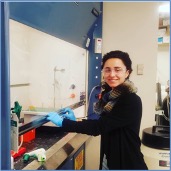Driving Energy Savings Through Occupant Engagement and Behavior Change
Those who drive energy efficiency initiatives are not always facility managers or sustainability coordinators; at the Colorado School of Mines campus, an occupant engagement and behavioral change program encourages green practices by involving those who spend the most time in labs: the people. Launched in August of 2018, the Colorado School of Mines deployed McKinstry's powerED program; working together, both organizations are driving new behaviors that save energy and money. The Shut the Sash campaign, started in March 2019, aims to save energy by encouraging lab users to close hoods when not in use and keep them low when working at them for safety reasons.

A student demonstrates sash safety.
The Colorado School of Mines campus includes more than 225 fume hoods across 10 lab spaces with an annual campus utility budget of more than $5 million. Knowing that one open fume hood wastes $1,100 in energy per year, this makes them the perfect target for a low/no cost behavioral change program. Beyond energy and cost savings, closing fume hood sashes while working is an important safety best practice. To kick-start the new initiative, the sustainability coordinator assembled a team comprising the campus facilities maintenance team, the Environmental Health and Safety department, and students involved in sustainability and marketing. This diverse team is a key component of the powerED program's overall success, as it fosters cross-department collaboration and engages multiple stakeholder groups.
To get feedback on progress, the team collected and visualized data from more than 50 individual hood exhaust flow rates. This data, based on an average of cubic feet per minute reduction, was used to communicate positive feedback to lab occupants and identify areas for improvement. Using the data visualization platform Tableau, the team was able to create visuals that distinctly show a shift in sash position and flow rates after the launch date of the program. To further encourage the adoption of Shut the Sash, the team engaged students by involving them in fume hood audits and improving social norming through commitment posters, lab training, and social media.

The Shut the Sash sticker serves as a reminder to students working in labs.
One barrier identified was that non-variable air volume (VAV) labs do not present energy savings from closed fume hood sashes, making traction slow in these lab spaces. Ultimately, the Shut the Sash initiative was adopted across non-VAV labs from successful social norming. Some behavior best practices identified by the team include reinforcing good behavior, offering rewards and recognition, consistently reviewing data for improvements, and sharing results with users. An additional barrier cited by the Mines team is that, although some labs failed to comply, their reasons were not always obvious. For example, misconceptions around fume hood use arose as justification for why they were not being shut in the first place. To combat the rumors, the team identified the greatest success by focusing on community-based social marketing. Strategies involved prompts, recognition, timely and relevant social media communications, and opportunities for sending feedback.
While defining success looks different across campaigns, and engagement can be difficult at times, the Colorado Schools of Mines powerED program was successful in shifting occupant behavior and saving energy with the Shut the Sash initiative. Through this program, Coolbaugh Hall—the largest lab building on campus—achieved cost savings of $12,000 to $15,000. Campus-wide, the program is expected to save over $22,000 a year with a goal of $30,000.
One of the great attributes of campaigns like Shut the Sash is how well they demonstrate the power of individual and community behavior and the reminder that, as you strive to decrease energy use, you cannot forget the human element. The program is looking to expand operations by verifying savings, performing night audits, examining total building exhaust flow, and looking into further certificates and awards.
Create an Occupant Engagement Program
- Build a diverse team comprising various stakeholders.
- Define success for your lab (visual inspections, energy savings month over month).
- Determine your audience and begin outreach.
- Communicate successes and share results though social media, rewards, recognition, and reinforcing good behavior.